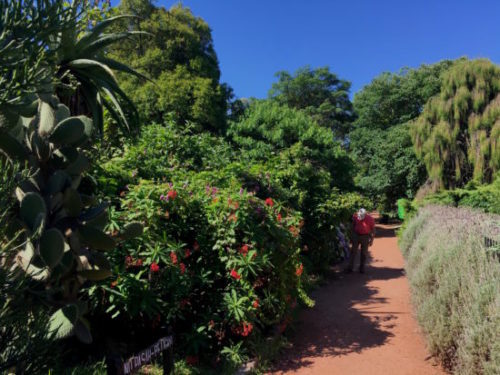To my readers: I am in Argentina for the month where I’ll be writing about gardens.)

Buenos Aires’ Jardín Botánico
There’s a reason why people often refer to Buenos Aires as a little Paris in South America. The city is chock full of French-style architecture, grand tree-lined avenues and a wide variety of public gardens. It wasn’t always this way, though. Up until the 19th century the city didn’t have many green spaces at all. That all changed with the arrival of a French landscape architect named Carlos Thays.
THE STORY OF CARLOS THAYS
Carlos Thays was to transform the city of Buenos Aires into the lush green metropolis it is today. Born in Paris in 1849, Thays was the disciple of one of the leading architects of the day, the French landscape architect Edouard André. Together with André, he helped design some of the most famous public and private gardens in Europe.

Thays came to Argentina in 1889 as part of a contract to help create what was to become his first major work in the country – the Parque Sarmiento, the largest park in the city of Córdoba. After the park was completed, he decided to stay in Buenos Aires. In 1891, he was named the city’s Director of Parks and Walkways.

Monument to Carlos Thays in Buenos Aires’ Jardín Botánico
The title of Parks Director gave Thays lots of leeway to influence the character of Buenos Aires, especially when it came to panoramic views of the city. With the exception of Parque Tres de Febrero, an older park opened in 1876, the city had no public green spaces. To rectify that, Thays began major tree planting projects. These included lining the grand avenues and neighborhood streets with such large shade trees as purple-flowering jacaranda, yellow-flowering tipas and the massive evergreen ombús,a native to the lowlands of South America.

One of the many Jacaranda trees in Buenos Aires
Simultaneously, Thays got to work remodeling the aging Parque Tres de Febrero and designing and constructing 69 new parks, gardens and plazas. His French heritage was reflected in many of his designs.
TOURING THE JARDÍN BOTÁNICO
One of the most famous of all of Thay’s projects is located in the urban neighborhood of Palermo where it takes up an entire city block. Completed in 1898, the Buenos Aires Botanical Garden is considered one of Thay’s greatest achievements. Today it bears his name Jardín Botánico Carlos Thays and it is home to more than 6,000 species of plants.

Surrounded on all sides by high walls, the park includes rare trees and a broad mix of native and exotic plants hailing from all parts of the world. The garden is also home to 33 classical sculptures, fountains and monuments in keeping with French style.

Canto de la Cosechadora

La Loba Romana, one of the garden’s many works of art
THREE MAIN GARDENS
In order to best display his collection of plants and landscape styles, Thays designed the Jardín Botánico in sections. There are three main gardens: a Roman Garden planted with huge cypresses, alamos (a variety of cottonwood) and laurel trees, a French Garden built around a classic symmetrical design and an Oriental-style Garden featuring species indigenous to Asia.

One of the many enormous cypress trees in the Roman Garden
While working on the construction and planting of the garden, Thays and his family lived in a large brick Gothic Revival style house that still occupies a central place in the garden. Today it is home to the city’s Garden School. It also features a revolving art collection and library.

Thays’ home during construction of the garden
JARDÍN BOTÁNICO’S GREENHOUSES
One of the Jardín Botánico’s most important features is the five greenhouses that house a wide variety of native and exotic plants. The largest of them, a Beaux-arts style building, was first erected at the Paris Exposition of 1889 and brought back to Buenos Aires to be reassembled in the garden. Measuring 35 meters long, it is now home to a couple thousand bromeliads and orchids.

The largest of the greenhouses

View inside the large greenhouse

View inside the bulb greenhouse
SPECIALTY GARDENS
In addition to the main garden sections, there are also a number of specialty gardens including a cactus garden and butterfly garden. The cactus garden features many unusual varieties of aloe.

Cactus garden walkway

Aloe marlothii from Africa
In January, the lovely African agapanthus plant flowers all over the garden.

In total, there are hundreds of flowering shrubs.

As well as huge stands of sky blue plumbago.

Thays died in Buenos Aires in 1934, but his public works live on for the whole city to enjoy. For more information on Buenos Aires’ Jardín Botánico, .




















